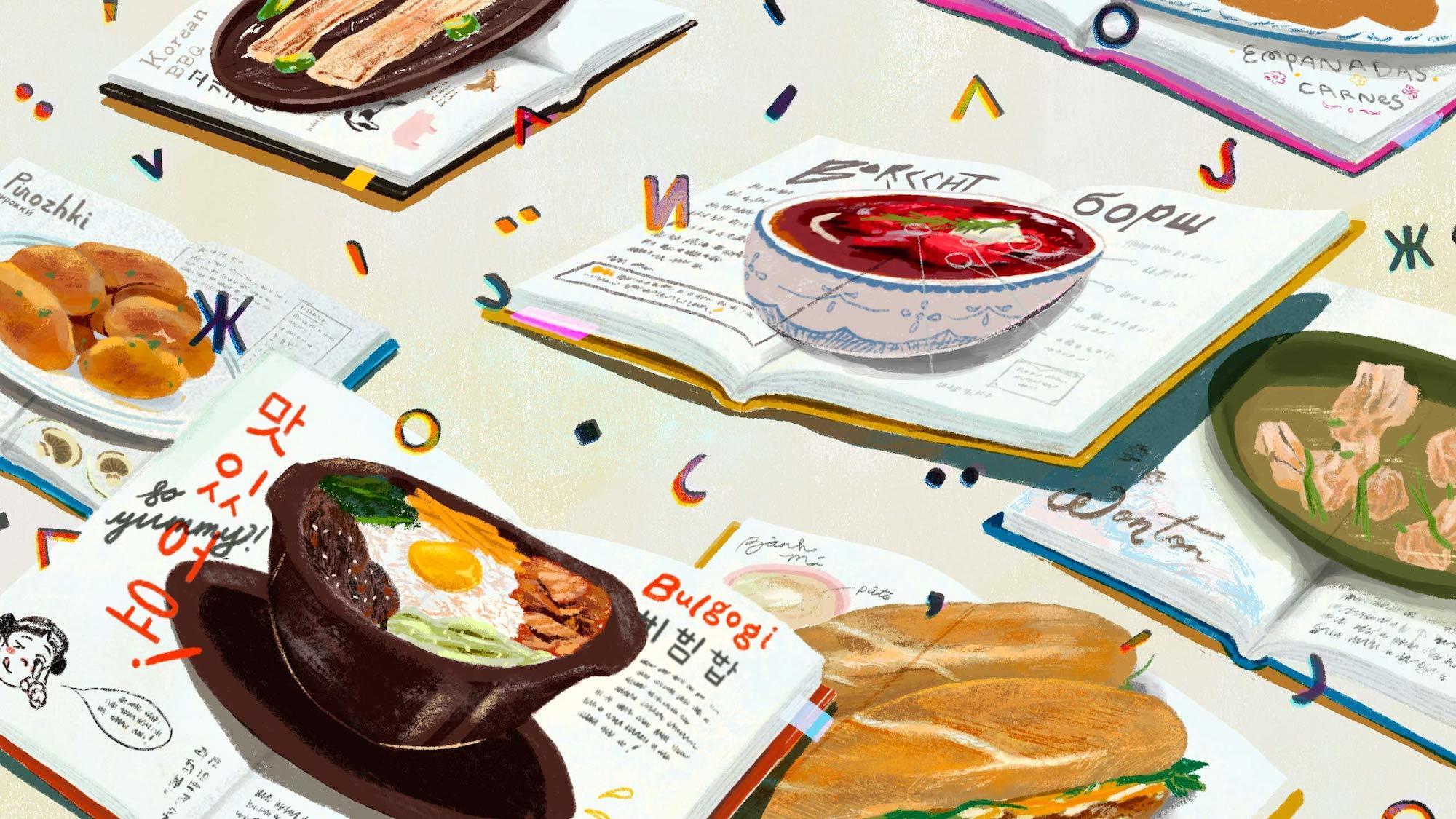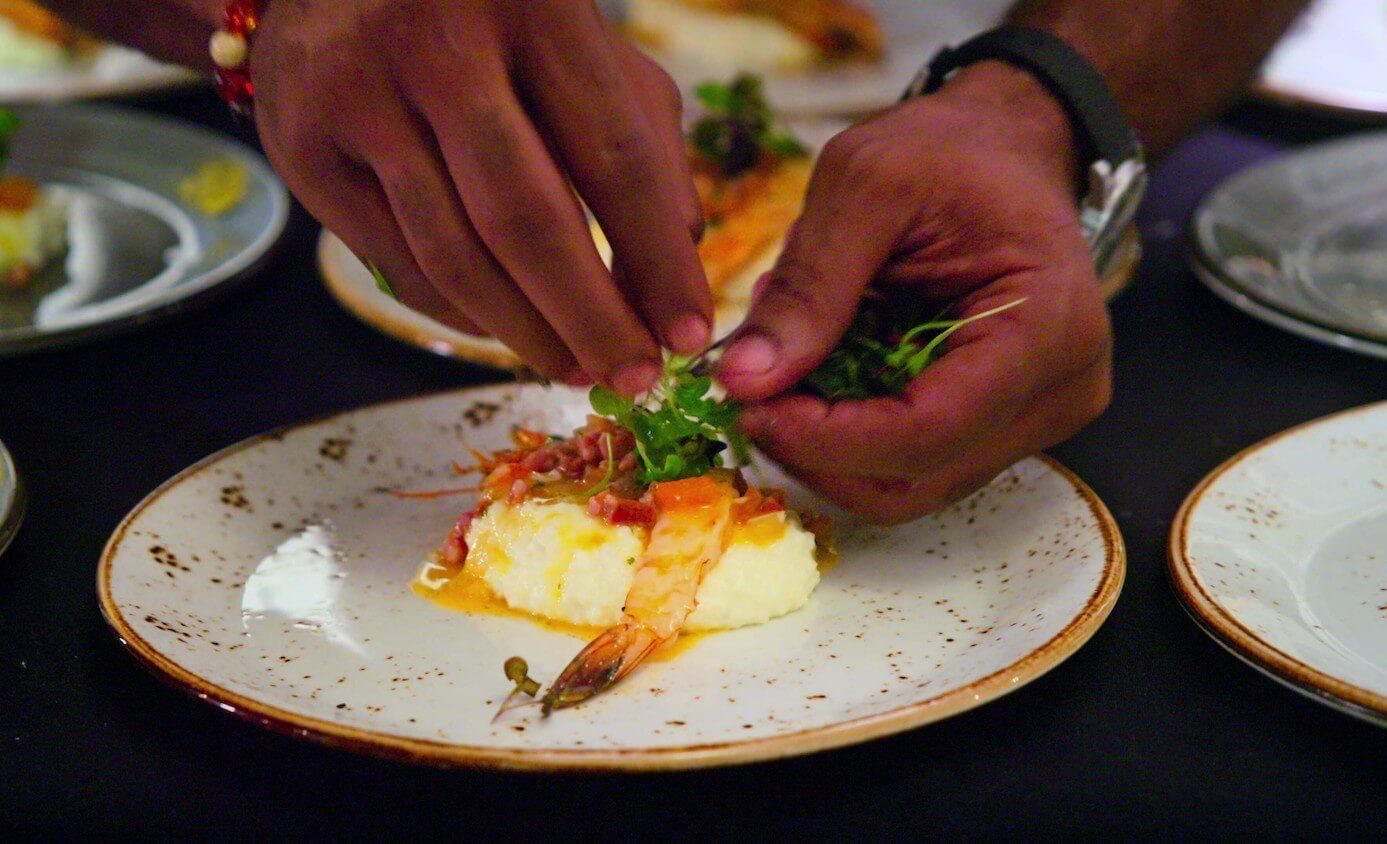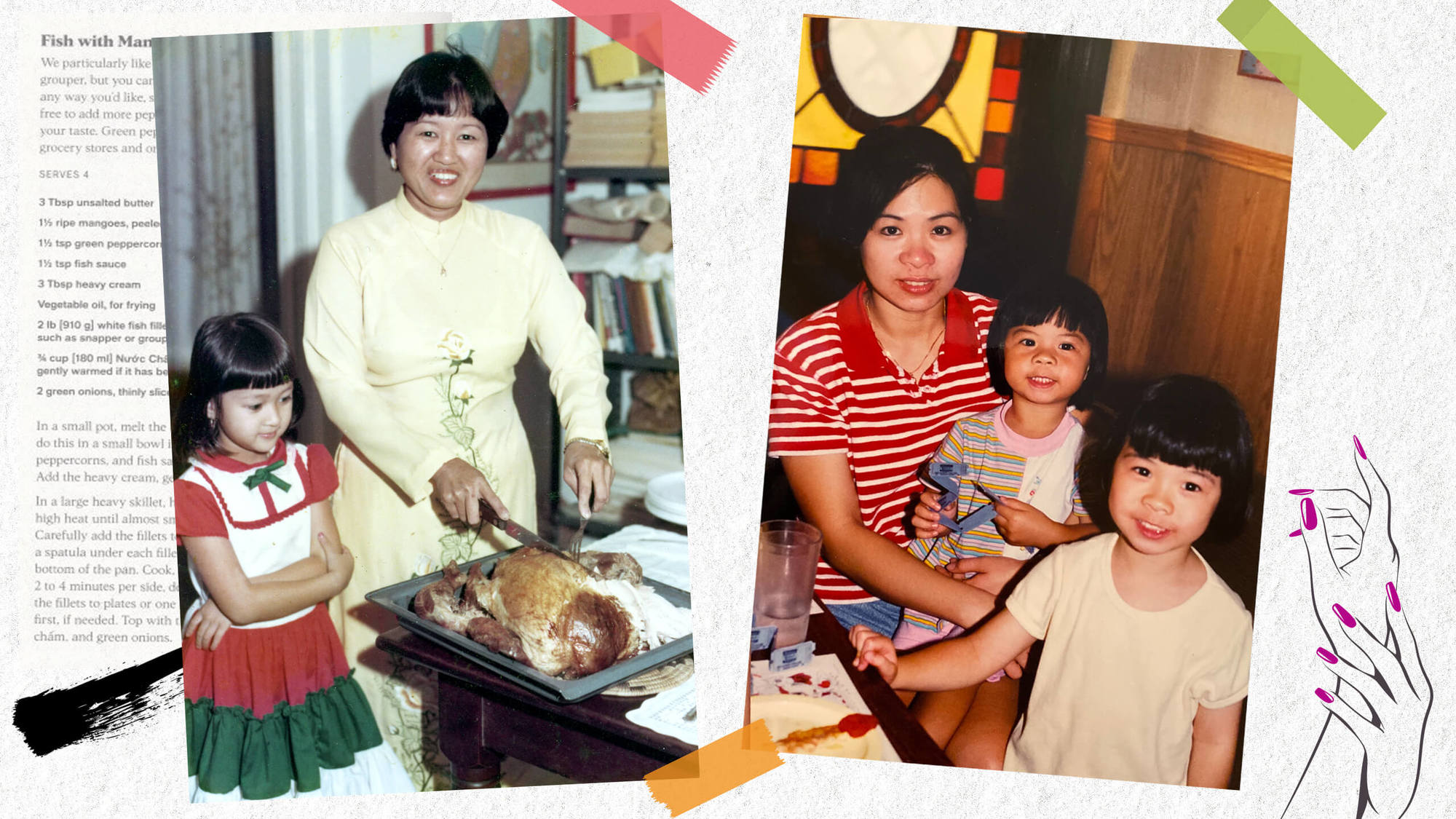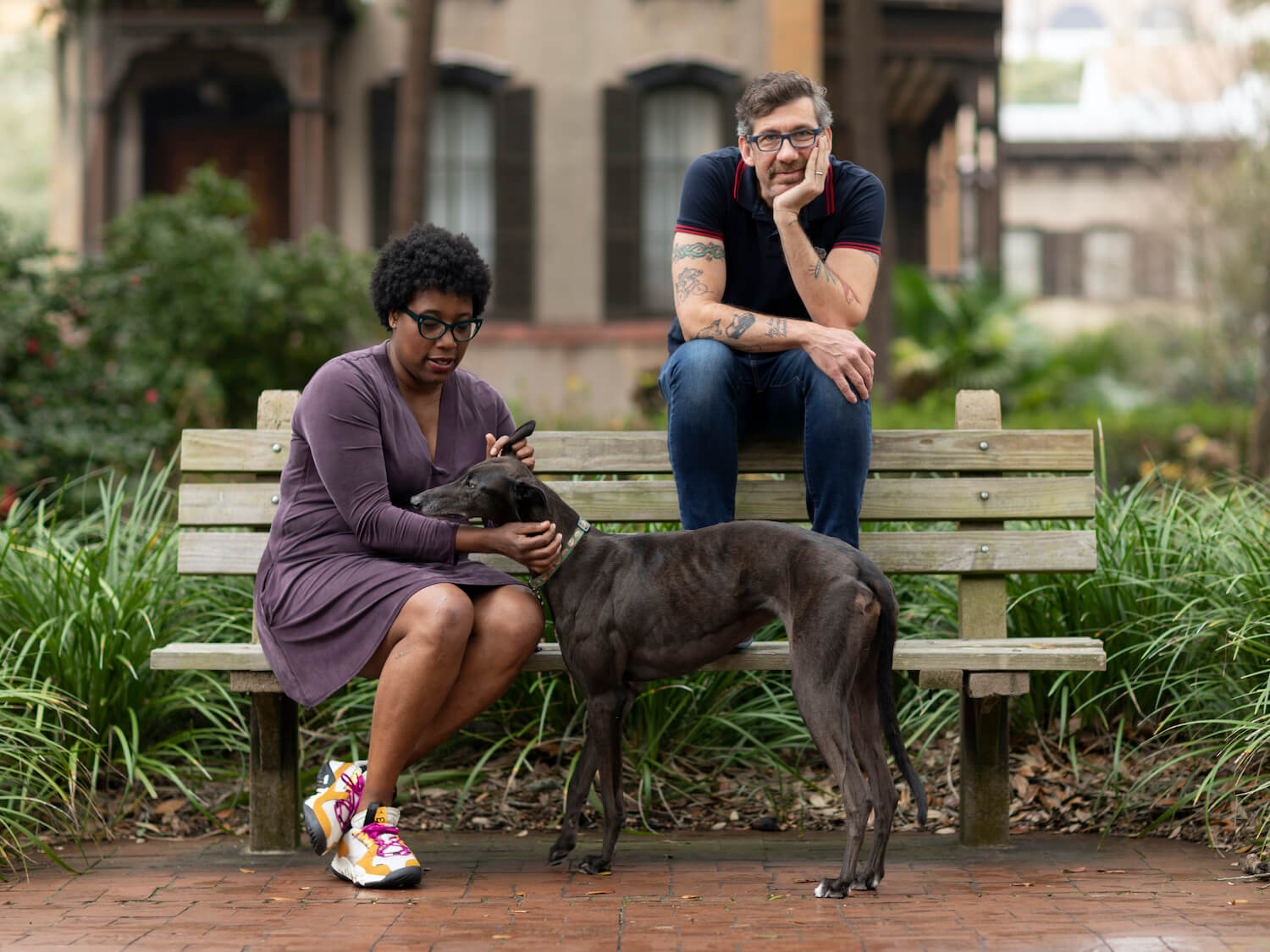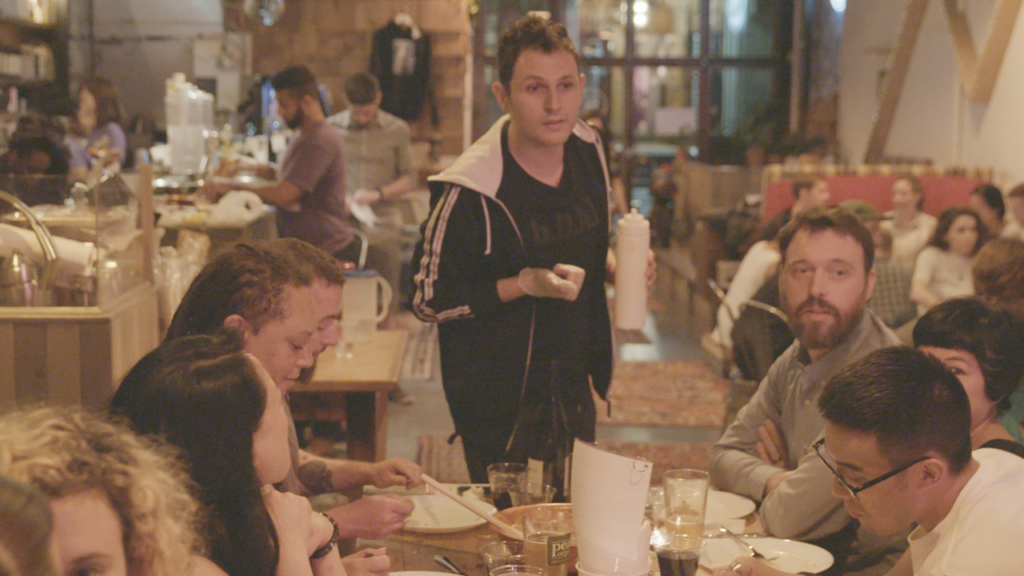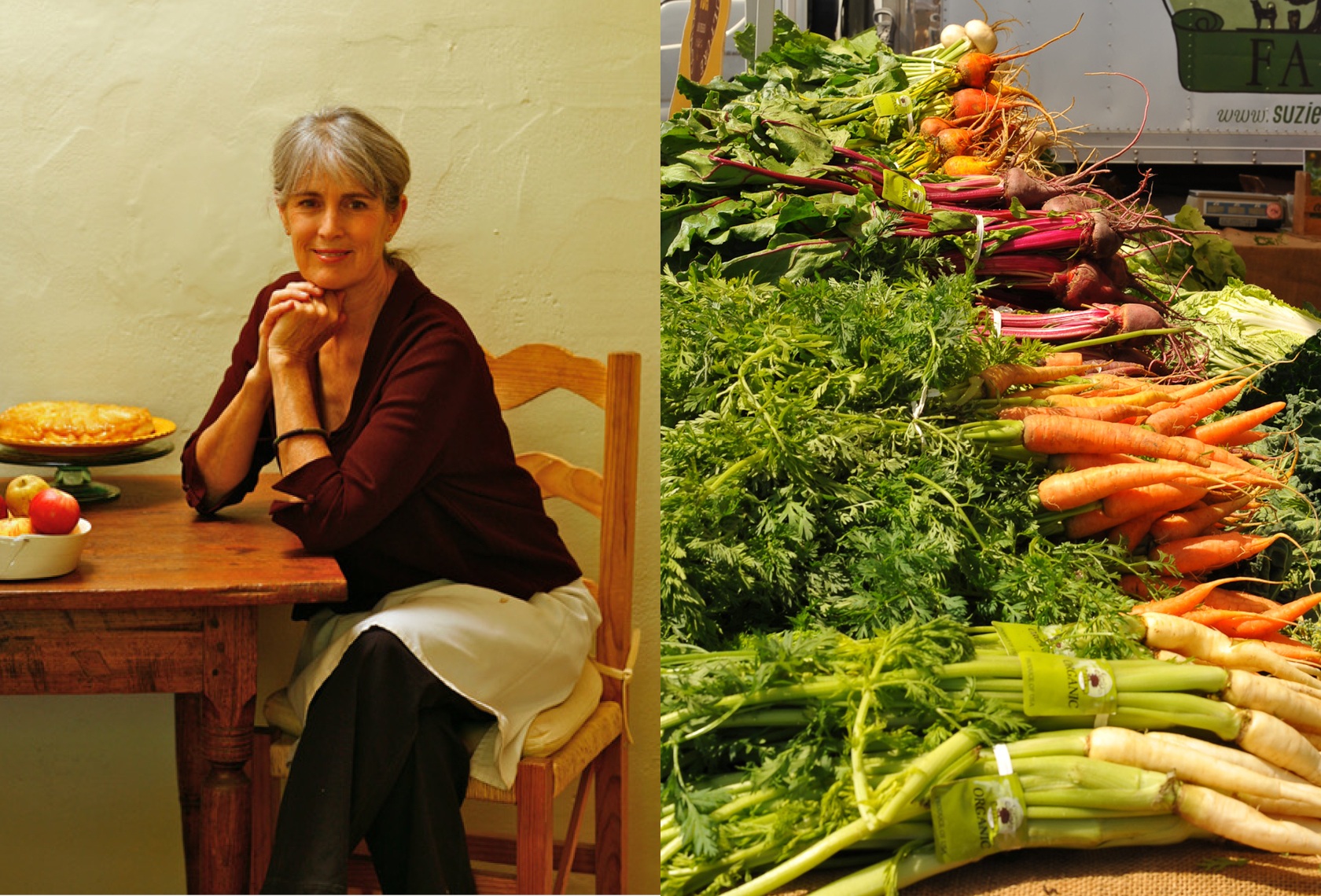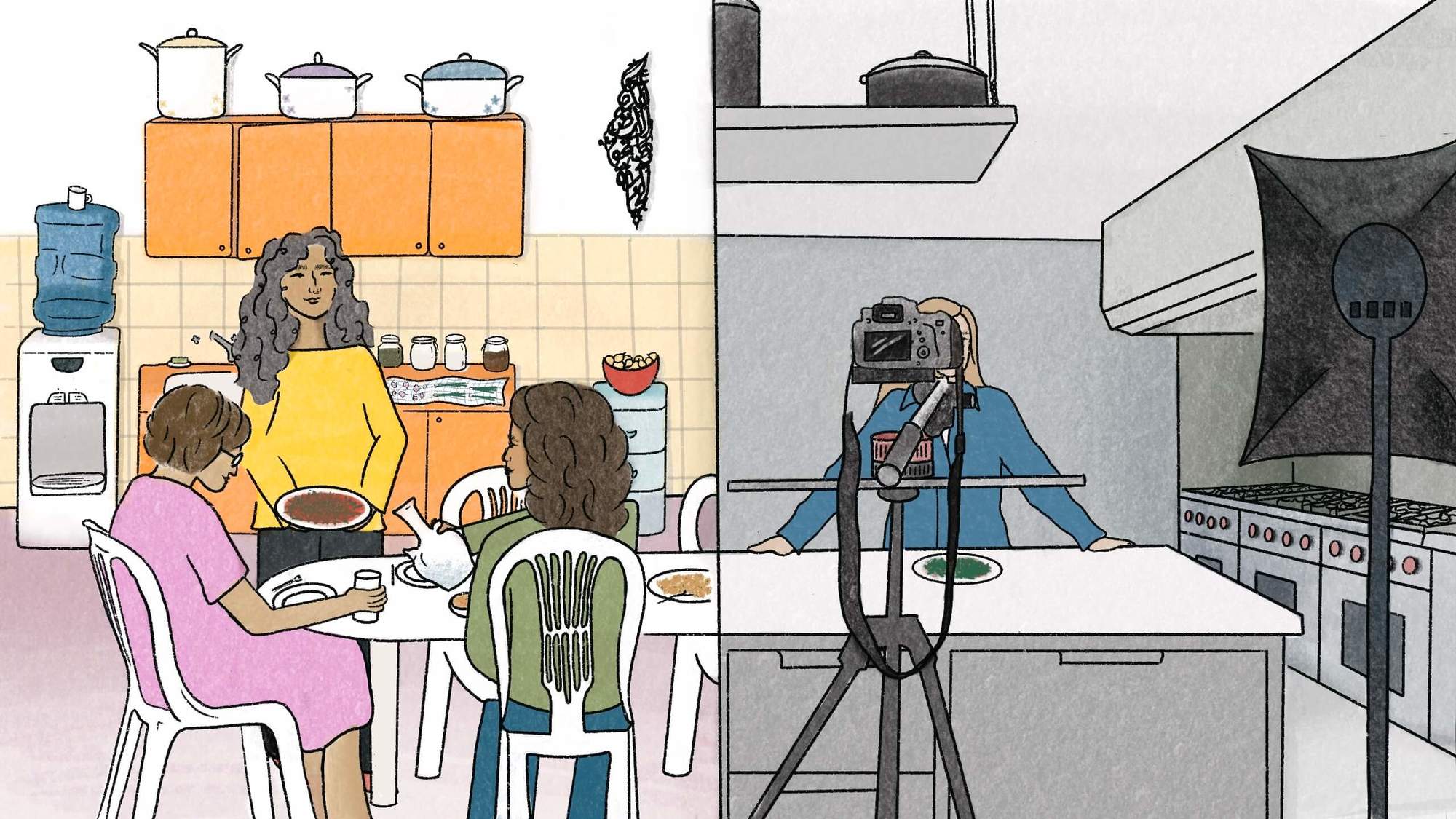
Yasmin Ahram
Buoyed by post-Arab Spring interest, a bumper crop of cookbooks perpetuates tropes of the pitiful and hard-working person displaced by conflict.
I am a little tired of the common wisdom, often repeated by both food media’s glossiest and most progressive publications, that food has the power to unite us.
Conflict often moves people from their nations, homes, and kitchens. And cookbooks that feature refugees often reveal an objectifying Western gaze that reduces them to their trauma.
Illustrations by Yasmin Ahram
This sentimentality shows up frequently in English cookbooks about the diverse cuisines of the Arab world. Friends ask if I find the latest publications “interesting” and “authentic,” especially if the books are about the region or the authors are Palestinian like me. In college, a well-meaning friend handed me one of those popular Yotam Ottolenghi cookbooks co-written with Sami Tamimi to globalize the success of their London eateries. Jerusalem (2008), in particular, underlined in bold that it was bringing you dishes eaten by all of the denizens of The Holy City, no matter what side they were on. At its heart, the recipes and photos of markets are a food-conquers-all narrative, aspiring toward Palestinian-Israeli coexistence. In other words, hummus will make everyone feel less angry about ethnic cleansing.
I was unaffected: Politics aside, I could make these dishes myself, without a recipe. As a child, I’d read pulp fiction near the kitchen where my mom or her friends, my khalas, cooked in the Palestinian countryside. Being within earshot, details seeped into my brain: why to specifically use chicken necks for stock, how to make quick-pickle eggplant. If I’m at my wits’ end in the kitchen, I call someone who knows my cuisines better than me.
But cookbooks are a good prism, a way to view Arabic-speaking peoples through the lens of what North American and Western European audiences want to see. I pay attention to the market.
Maybe, to you, cookbooks are neutral tools, pretty to look at, or part of middle- and upper-class leisure.
So I noticed when the broad genre I call “the refugee cookbook,” recipes served with a dose of pity for refugees, began to surface around 2015—just enough production time to crank out books post-Arab Spring. Soup for Syria was among the earliest that caught my eye, and while political events initially focused the trend on Syria, it has continued with books such as this spring’s release of The Kitchen Without Borders, partly about a New York-based refugee culinary training program.
Perhaps the latest entry in the refugee cookbook catalog is British-Iranian barrister-turned-activist Yasmin Khan’s Ripe Figs: Recipes and Stories from Turkey, Greece, and Cyprus (her third book after 2017’s Zaitoun on Palestinian food and her travels in Palestine, and 2015’s The Saffron Tales, on Persian cuisine).
The book’s epitaph reveals its framing: “Most of all, [this] is a book about the resilience of the human spirit. And our capacity to endure the most unimaginable challenges and still find happiness in the smell of warm bread baking in an oven, a scoop of pistachio ice cream on a hot summer’s day, or a bowl of roasted pumpkin soup eaten by a roaring fire. And it’s dedicated to all the migrants.”
Ripe Figs features the foods and peoples who live in Cyprus, Turkey, and Greece in some way; this includes many of the displaced peoples of the world. Centered around the theme of a borderless world, Ripe Figs is organized by category: breakfasts, breads and grains, mezzes and light meals, salads, soups, mains, and desserts. Khan says that the recipes, which she developed at home in London, reflect her “understanding of a crisis that is unfolding and that we simply can’t ignore.” Interludes knit the recipes together into a narrative in which Khan shares stories of her visits and the people she meets as she ambles through Europe and the Asian part of Istanbul. Sometimes she reminisces about her own childhood: holidays taken with her parents and siblings, how her family used to host political refugees in their home.
In the refugee cookbook, displaced peoples are industrious. They get down to work, whenever life is hard, part and parcel of resilience.
In Ripe Figs, there’s a formulaic wretchedness to the portrayal of the displaced individual: what someone fled, how they cook, their limited resources, how generous they are despite it all. These featured people only get a few lines before Khan moves on, either to a description of the landscape or the recipes, very few of which mention individuals she’s met. Earlier in the book, when Khan spends time in Athens, visiting a community center for migrant and refugee women, her attention centers on the saviors of refugees, set amid food. There, we do not meet any of the individuals seeking help, which is perhaps for the best, because the few references are to their abjection and suffering, especially prior to the center’s establishment.
Another imbalance exists: Displaced peoples—especially in Turkey, Greece, and Cyprus—are stuck, waiting for an opportunity to get to the next safe place. They wait in camps for visas; they hide from authorities who might deport them. Amid the stress of a life on the move, they keep an eye on home and what politics swirl in Syria, Libya, or Afghanistan. Yet Khan can travel, wandering through cityscapes with a pastry in hand. It’s a freedom of mobility she hasn’t always had. During her childhood, her family could not always easily visit Iran (they emigrated in the 1970s). Maybe it’s why these travelogue-cookbooks feel cursory and touristic. Whatever the reason, Khan affords herself a humanity her ostensible subjects—in her telling—lack.
This tendency is especially strong in 2015’s Soup for Syria; it’s certainly the first book I remember that was so brazen in how it reduced the displaced peoples of Syria to a single dimension. A fundraiser, the book features soup recipes by celebrity chefs and various home cooks from Lebanon, also where Barbara Abdeni Massaad, the book’s editor, was born before moving to the United States as a child. More egregious than Ripe Figs, most of Soup’s photos are of Syrians with dirty faces in makeshift homes strewn with garbage and tattered clothes. There are barely any pictures of the titular soups. The photos, shot by Massaad, are always of women, children, or older men—never younger men because audiences from Europe, the United States, and Canada are often presented with visions of refugee men as dangerous, never empathetic. It’s why when we do see younger men, they’re very carefully presented, so as not to make anyone uncomfortable. The audience is prioritized over all.
To be sure, refugee cookbooks don’t always use the term “refugee”; there’s the understanding that the word has fallen out of favor in some circles. Using a term to describe an entire people, to define their personhood is never appropriate. It strips them of everything else.
In the case of refugee cookbooks, their authors want to have it both ways—to draw emotional and moral authority from crisis, while avoiding getting their own hands too dirty.
Even as both Ripe Figs and Soup for Syria appeal for Syria, Afghanistan, and beyond, the books don’t advocate for specific solutions to the actual problems causing displacement, while using refugees to sell books. The resulting portraits are defined by violence but oddly apolitical, as if to suggest that the conflicts they chronicle indirectly are perpetual ways of life, crises without origin, and without end. As if we might as well not worry about when or why or how.
The portrayal of displacement and its wretchedness has a counterpart in these cookbooks: the portrayal of resilience. On every other page in Soup for Syria, the reader is presented with faces smiling despite the pain, forbearance on display, to inspire the reader as they tackle the challenges of day-to-day life, like commuting or a broken pipe. But again, they’re dusted onto the book, even in the interludes. In Ripe Figs’ Istanbul scenes, Khan spends very few words on Syrian refugees there, with a brief mention of the businesses they’ve started and other elements of community.
But even that morsel in Istanbul is telling. In the refugee cookbook, displaced peoples are industrious. They get down to work, whenever life is hard, part and parcel of resilience. The Kitchen Without Borders: Recipes and Stories From Refugee and Immigrant Chefs tells stories of people who come through New York’s Eat Offbeat kitchen: It’s a global group, from Syria, Iraq, Iran, and other nations. As I read their recipes—mostly classics like kibbeh, daal, and mjaddara—alongside their stories of sexual assault and political persecution, I wondered if the goal or effect of this is to portray these people as the “good refugee,” who deserve citizenship because they “benefit society” despite their trauma.
That’s probably not an accident. With a few exceptions, the food of the Arabic-speaking world is largely written about by outsiders to those communities. Similarly, refugee cookbooks by and large reduce human beings to their displacement. The books’ luxurious paper, detailed descriptions, and colorful images exist to maximize horrific conditions these peoples endure and celebrate their resilience, almost as if to say that if anyone had to undergo such horrors, it’s lucky it’s someone so strong.
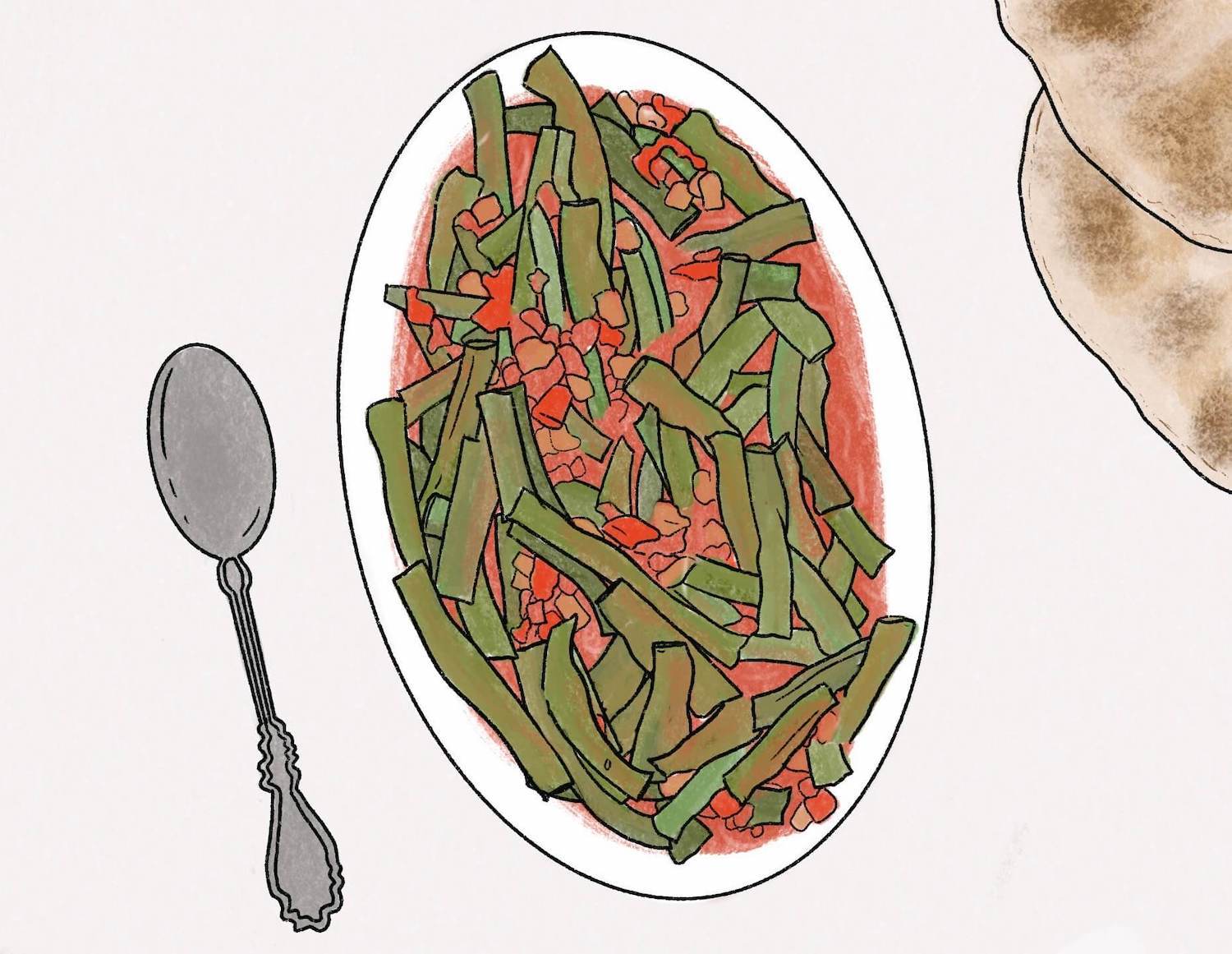
Our Syria, a 2017 book by Itab Azzam and Dina Mousawi, includes stories of displaced Syrian women in Lebanon, placed between recipes for different mezze and classic mains like lubiya bi-banadora, illustrated here.
Yasmin Ahram
Maybe, to you, cookbooks are neutral tools, pretty to look at, or part of middle- and upper-class leisure. I firmly believe cookbooks are always political, even conceptually. To cook requires resources, and resources are not available to all. And in the case of refugee cookbooks, their authors want to have it both ways—to draw emotional and moral authority from crisis, while avoiding getting their own hands too dirty.
That’s why the “resilience” narratives are so important: They invoke the political in a facile way, while avoiding opportunities for more nuanced engagement. Cookbooks capitalize on this sprinkling of politics. The authors establish themselves as politically conscious global citizens, often attempting to provide or promote financial support for displaced peoples. Soup for Syria’s proceeds went to refugees in the Bekaa Valley. Ripe Figs features an addendum of refugee aid organizations to which readers can donate. But is financial support where our simulated sympathy ends?
Ultimately, the effect is not necessarily to support the displaced peoples of the world, but to comfort the reader. The reader is made benevolent through their support of these refugees. After all, they purchased the book.
These tropes in the last decade’s cookbookery are most evident in works about the Syrian community, particularly those written by outsiders. But they do show up when Syrian-authored cookbooks hit the market. Some Syrians also reach for resilience and displacement narratives. Our Syria, a 2017 book by Itab Azzam and Dina Mousawi, includes stories of displaced Syrian women in Lebanon, placed between recipes for different mezze and classic mains like lubiya bi-banadora.
The reader is made benevolent through their support of these refugees. After all, they purchased the book.
Even books by Syrians that center on personal narratives and food history are marketed to or interpreted through a Western vision of the “Middle East,” an amorphous conflict zone. Media coverage of 2021’s Sumac describes author Anas Atassi as a refugee and the difficulty of fleeing Syria. Yet he does not mention displacement in the text itself. Sumac is an ode to family and to diaspora: coming home during summers and learning the food, cooking it wherever you are. His “Mom’s Famous Beet Salad” is a sharp and clear human moment, one we don’t see enough of in cookbooks produced for English-speaking audiences.
That said, other Syrian cookbook writers explore community through history rather than family. Marlene Matar’s The Aleppo Cookbook focuses on a single city, and she is heavy-handed with the detail. Aleppo’s distinction as a food city is proclaimed through its racial diversity, trading history, and the dozen or so varieties of kibbeh. But feature articles about Matar’s book always mention the destruction of Aleppo, despite no mention in the book itself.
Coverage of Matar’s book is a testament to how poor English-language food writing has been on the Arabic-speaking world writ large. With few writers from our own communities—be they Syrian, Sudanese, or Tunisian—on food discourse, the field is largely represented by white writers who have a very limited understanding of the cultures they write about and thus, a limited understanding of the implications of how they frame food.
As someone who is not Syrian, I am not here to make assertions on how Syrians should portray themselves or their food. Those conversations must happen inside communities, and the value of resilience narratives will differ from place to place and among individuals. I hope that, for Atassi, Matar, and Azzam, cookbookery yields some catharsis, no matter how the outside world seeks to define them.
However, I question the framing of food from the Arabic-speaking world in English-language media. I’m tired of seeing the food-brings-us-together concept show up in cookbooks featuring the foods of people from, say, Morocco to Iraq because Middle Eastern and North African cuisines have been relatively sidelined in food media. When was the last time you saw za’atar other than thrown onto your roast chicken, as both an afterthought and to make your dinner a little exotic? What about a feature on the history of a Sudanese or Algerian community in the United States, and how they’ve adapted their food?
In reportage and cultural criticism, the newsman and the commentator’s reflex is to portray [people from the Arab world] as perennial refugees and ingovernables—but our food’s good.
Beyond the simple fact that refugee cookbooks edge into politics when convenient, food has parallels in larger social politics; it reflects mainstream understandings. Fighting dictatorship and political oppression is romantic at first, but the violence that often follows regime change affirms the Western public’s longstanding belief that the people over there are violent and pitiful at the same time. In reportage and cultural criticism, the newsman and the commentator’s reflex is to portray us as perennial refugees and ingovernables—but our food’s good.
Cookbooks, as the only real representation the Arabic-speaking world has in food writing outside Twitter, are doing us a poor showing. While the door has been opened by cookbooks like Ripe Figs, it’s also closing behind them. Based on the market, Western appetites, and its success, editors will ask cookbook writers to make their books a little more like Ripe Figs, with little nuanced understanding of the region.
Maybe the only solution is not quite to join that small but growing bookshelf of titles, but to expand food writing from the Arabic-speaking world itself. There is far more to explore outside the cookbook or the memoir with recipes, outside the migrant camps, and refugee culinary training programs. A few excellent food writers—Liana Aghajanian, Farrah Berrou, Fadi Kattan, among others –—are carrying the burden of speaking for and from the region in English-language food media. Social media has existed as a liberatory space for food, as has the blogosphere, with Assyrian, Iraqi, Palestinian, and Yemeni voices tumbling through the social media algorithms.
But capital doesn’t flow cleanly to social media: You need followers to generate book and ad deals, and nonwhite people are both less likely to get such deals. When they do, they’re less lucrative because nonwhite audiences, specifically those from the Arabic-speaking world, are seen as niche. As for discourse, we don’t get paid for tweets or long Instagram posts: Our intellectual labor is futile in such an information economy. We need a foot in the door of cultural criticism to discuss the refugee cookbook and everything it touches.
The refugee cookbook did not begin with the forced migration of Syrians. It won’t end there either, especially as we face another wave of people fleeing Daraa and Idlib, both in Syria, as well as Afghanistan. It’s easier to just follow the same script: to offer refuge to tiny numbers of displaced people, give them minimum-wage jobs making pita bread for our bakeries, and to praise ourselves for our generosity.

